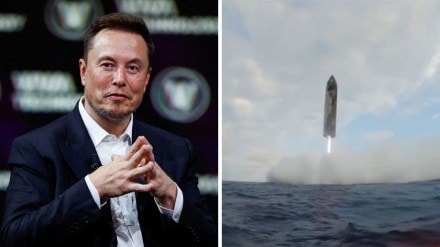In a major breakthrough for SpaceX, CEO Elon Musk in a post on X shared a rare footage of a Starship upper stage making a vertical water landing. “This is a real video of a past @SpaceX Starship water landing. Trying again tomorrow. We need to perfect ship reentry at extreme temperatures before attempting to catch the ship with the tower arms, like the booster,” Musk wrote.
In another tweet, Musk confirmed that his company will proceed with its next Starship test flight on Monday and stressed on the importance for SpaceX to perfect the spacecraft’s reentry under extreme temperatures before attempting a tower-arm catch.
This is a real video of a past @SpaceX Starship water landing.
— Elon Musk (@elonmusk) March 2, 2025
Trying again tomorrow.
We need to perfect ship reentry at extreme temperatures before attempting to catch the ship with the tower arms, like the booster.
pic.twitter.com/tss9Lb4fWr
SpaceX prepares for next Starship test
SpaceX is gearing up for the next test flight of Starship, just six weeks after its previous attempt ended in a mid-air explosion over the Atlantic Ocean. In preparation, the company has introduced several hardware and operational upgrades aimed at boosting the rocket’s reliability.
This upcoming mission will focus on critical objectives, including Starship’s first-ever payload deployment, conducting reentry experiments, and attempting to catch the Super Heavy booster upon return — a key milestone in SpaceX’s push for full reusability.
Following an internal investigation into the previous flight’s failure, SpaceX revealed that multiple changes have been made to Starship’s hardware and operations to enhance the performance of its upper stage. “After concluding our review of the seventh flight test, we’ve implemented significant improvements across both hardware and flight procedures,” SpaceX confirmed in a blog post.
All you need to know about SpaceX’s next mission
Like previous tests, the mission will follow a suborbital path, but this time, SpaceX aims to achieve new benchmarks, such as successfully deploying a payload and gathering critical data from reentry maneuvers. These experiments are essential for developing Starship’s future ability to safely return to its launch site for reuse.
A major highlight of the flight will be the Super Heavy booster’s return and a potential catch attempt using the launch tower’s giant “chopsticks” — a bold move that SpaceX believes will be a game-changer for reusable rocket technology.
Key hardware upgrades include redesigned forward flaps for improved heat protection and simpler mechanical function, a 25% boost in propellant capacity to support longer missions, and a fully upgraded avionics system designed to handle advanced tasks such as in-orbit refueling and precision landings.
SpaceX acknowledged that test flights come with inherent risks, but stressed that every flight delivers valuable data to accelerate development. “Frequent testing allows us to rapidly learn and improve, bringing Starship closer to becoming a fully operational, rapidly reusable spacecraft,” the company emphasised.
